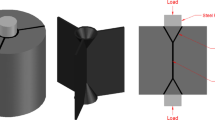Abstract
Split-cylinder fracture of fiber-reinforced ultra-high-performance concrete (UHPC) was examined using two complementary techniques: X-ray computed tomography (CT) and acoustic emission (AE). Fifty-mm-diameter specimens of two different fiber types were scanned both before and after load testing. From the CT images, fiber orientation was evaluated to establish optimum and pessimum specimen orientations, at which fibers would have maximum and minimum effect, respectively. As expected, fiber orientation affected both the peak load and the toughness of the specimen, with the optimum toughness being between 20% and 30% higher than the pessimum. Cumulative AE energy was also affected commensurately. Posttest CT scans of the specimens were used to measure internal damage. Damage was quantified in terms of internal energy dissipation due to both matrix cracking and fiber pullout by using calibration measurements for each. The results showed that fiber pullout was the dominant energy dissipation mechanism; however, the sum of the internal energy dissipation measured amounted to only 60% of the total energy dissipated by the specimens as measured by the net work of load. It is postulated that localized compaction of the UHPC matrix as well as internal friction between fractured fragments makes up the balance of internal energy dissipation.
Similar content being viewed by others
References
FHWA. Ultra-High Performance Concrete. Tech Note FHWA-HRT-11–038. 2011
Fehling E, Middendorf B, Thiemicke J. Ultra-High Performance Concrete and High Performance Construction Materials. Kassel: Kassel University Press, 2016
Balaguru P, Shah S. Fiber-Reinforced Cement Composites. New York: McGraw-Hill, 1992
Bentur A, Mindess S. Fiber Reinforced Cementitious Composites. London: Elsevier, 1990
Yoo D Y, Banthia N. Mechanical properties of ultra-high-performance fiber-reinforced concrete:A review. Cement and Concrete Composites, 2016, 73(C): 267–280
Trainor K J, Foust B W, Landis E N. Measurement of energy dissipation mechanisms in fracture of fiber-reinforced ultra-high-strength cement-based composites. Journal of Engineering Mechanics, 2013, 139(7): 771–779
Williams E M, Graham S S, Reed P A, Rushing T S. Laboratory Characterization of Cor-Tuf Concrete With and Without Steel Fibers. Technical Report ERDC/GSL TR-09-22. 2009
Roth M J, Rushing T S, Flores O G, Sham D K, Stevens J W. Laboratory Investigation of the Characterization of Cor-Tuf Flexural and Splitting Tensile Properties. Technical Report ERDC/GSL TR-10–46. 2010
Wille K, Naaman A. Pullout behavior of high-strength steel fibers embedded in ultra-high-performance concrete. ACI Materials Journal, 2012, 109(4): 479–487
Harris D O, Bell R L. The measurement and significance of energy in acoustic emission testing. Experimental Mechanics, 1977, 17(9): 347–353
Landis E N, Baillon L. Experiments to relate acoustic emission energy to fracture energy of concrete. Journal of Engineering Mechanics, 2002, 128(6): 698–702
de Wolski S C, Bolander J E, Landis E N. An in-situ X-ray microtomography study of split cylinder fracture in cement-based materials. Experimental Mechanics, 2014, 54(7): 1227–1235
Flanders L S. A 3D image analysis of energy dissipation mechanisms in ultra high performance concrete subject to high strain rates. Thesis of the Master’s Degree. Orono: University of Maine, 2014
McSwain A C, Berube K A, Cusatis G, Landis E N. Confinement effects on fiber pullout forces for ultra-high-performance concrete. Cement and Concrete Composites, 2018, 91: 53–58
Mondoringin M R I A J, Ohtsu M. Kinematics on split-tensile test of fiber-reinforced concrete by AE. Journal of Advanced Concrete Technology, 2013, 11(8): 196–205
Acknowledgements
This work was supported by the Engineer Research and Development Center (ERDC) of the U.S. Army Corps of Engineers through a subcontract with ES3 Inc. The work Todd Rushing and the ERDC Materials Branch for their assistance fabricating the UHPC specimens is gratefully acknowledged, as is the assistance of Jeramy Magruder and George Lopp at the University of Florida Advanced Materials Characterization Laboratory. Permission to publish this information was granted by the Director, Geotechnical and Structures Laboratory, ERDC.
Author information
Authors and Affiliations
Corresponding author
Rights and permissions
About this article
Cite this article
Landis, E.N., Kravchuk, R. & Loshkov, D. Experimental investigations of internal energy dissipation during fracture of fiber-reinforced ultra-high-performance concrete. Front. Struct. Civ. Eng. 13, 190–200 (2019). https://doi.org/10.1007/s11709-018-0487-1
Received:
Accepted:
Published:
Issue Date:
DOI: https://doi.org/10.1007/s11709-018-0487-1




